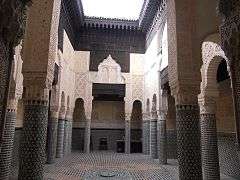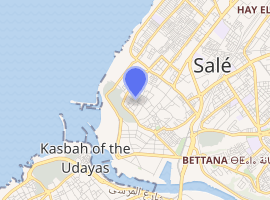Madrasa of Abu al-Hasan
The Madrasa of Abu al-Hasan, also referred to as the Marinid Madrasa (of Salé), is a medieval madrasa located within the old city of Salé, Morocco. It was founded or built in 1341 by the Marinid sultan Abu al-Hasan and is notable for its rich decoration.[1][2][3] It is right next to the Grand Mosque of Salé.
| Madrasa of Abu al-Hasan | |
|---|---|
 The courtyard of the madrasa. | |

| |
| Alternative names | Marinid Madrasa (of Salé) |
| General information | |
| Type | madrasa |
| Architectural style | Marinid, Moroccan, Moorish, Islamic |
| Location | Salé, Morocco |
| Coordinates | 34°02′23.5″N 6°49′38.1″W |
| Completed | 1341 |
Architecture
The madrasa is entered through an ornate stone portal with a horseshoe arch doorway. This entrance leads to a small vestibule, from which a staircase on the side leads to the upper floor. Beyond the vestibule, one enters sideways into the corner of the central courtyard, which is measures about 8 by 5 meters.[2] The courtyard is paved with zellij tilework, features a small central fountain, and is ringed by a gallery of round masonry columns that uphold stucco and wood-carved decorated facades.[2] The spaces between the gallery columns and the outer wall of the courtyard are covered by painted wood ceilings carved into geometric star patterns, one part of which has been restored to its approximate original colours.[3] The whole building, like the nearby Grand Mosque, is aligned or oriented with the qibla (direction of prayer) of the time (i.e. roughly southeast). Accordingly, at the far end of the courtyard is a large rectangular prayer room featuring a mihrab (a niche symbolizing the direction of prayer), around which are more intricate stucco-carved surfaces and windows. The room is divided into three spaces by arches on either side of the mihrab and covered by more timber ceilings.[3][2] The upper floor is occupied by the student cells and living quarters. Unlike other madrasas of this type, the students' rooms do not have windows looking into the courtyard.[3]
Possibly even more than other Marinid madrasas, this building shows similarities with Nasrid art and architecture (e.g. the palaces of the Alhambra), attesting to the shared artistic vocabulary between the two regions.[1] The decoration consists of zellij tilework covering the floor and the lower walls, transitioning into intricately carved stucco decoration above, and topped by carved cedar wood surfaces and a wooden canopy above.[2] Both the wood and the stucco are carved with calligraphic decoration and with a variable repertoire of geometric, arabesque, and floral/vegetal patterns.[3] A rectangular marble panel carved with a foundation inscription of the building was originally set into the northwestern wall of the courtyard (opposite the mihrab and the prayer room).[3]
- The entrance portal of the madrasa.
 The courtyard of the madrasa, looking towards the mihrab.
The courtyard of the madrasa, looking towards the mihrab. Stucco and wood carvings on one of the lateral galleries of the courtyard.
Stucco and wood carvings on one of the lateral galleries of the courtyard. A restored painted wooden ceiling under one of the courtyard galleries.
A restored painted wooden ceiling under one of the courtyard galleries. The mihrab of the prayer room.
The mihrab of the prayer room. The student cells on the upper floor.
The student cells on the upper floor.
References
| Wikimedia Commons has media related to Marinid Madrasa of Salé. |
- Kubisch, Natascha (2011). "Maghreb - Architecture" in Hattstein, Markus and Delius, Peter (eds.) Islam: Art and Architecture. h.f.ullmann.
- Marçais, Georges (1954). L'architecture musulmane d'Occident. Paris: Arts et métiers graphiques. pp. 289–290.
- Parker, Richard (1981). A practical guide to Islamic Monuments in Morocco. Charlottesville, VA: The Baraka Press.